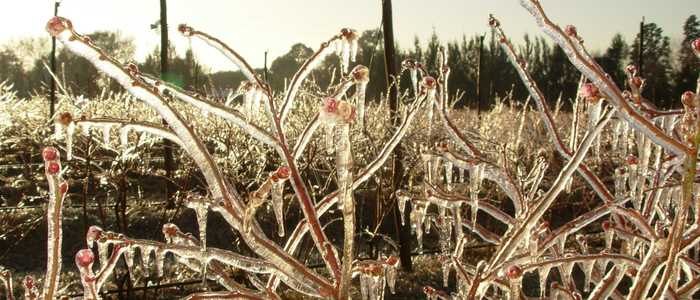Anticipating Frost: Why Early Preparation is Key for Crop Protection
Late frosts are among the most significant natural hazards threatening farming production worldwide. Their frequency and severity are increasing due to climate change, which has led to unpredictable weather patterns.
While global temperatures continue to rise, they also cause earlier blooming, leaving crops vulnerable to sudden cold snaps. This phenomenon has already resulted in severe agricultural losses, particularly affecting fruits such as cherries, apples, grapes, and citrus.
Frost Protection: The Importance of Timely Action
The knowledge of local meteorology should support the acquisition of passive protection systems and improve the active ones.

But one thing is absolutely essential for all systems: you must start on time. One of the main causes of frost damage is that protection systems are being started too late, for many reasons:
- you do not have a frost alarm system
- you are starting your protection system based on a dry temperature
- the frost alarm is not placed in the right place
- the temperature sensor is installed too high
What should a frost protection system consist of?
- site-specific weather forecast, and
- accurate real-time information about temperature and other key frost parameters in the crops. In particular:
- wet bulb temperature that better represents the temperature of the leaf during frost conditions and it tells the right moment when to start the irrigation system.
What should you pay attention to?
IMPORTANT
- sensors should be installed in the coldest spot of the orchard/vineyard (lower sites have a lower temperature) and
- at the height of the lowest flowers or fruits.
 Monitoring dew point is also a solution, but only under the most common frost scenarios. The parameter is available on the platform Fieldclimate. The rule of thumb is that the Tmin on a given morning will approach the dew point value taken the prior evening.
Monitoring dew point is also a solution, but only under the most common frost scenarios. The parameter is available on the platform Fieldclimate. The rule of thumb is that the Tmin on a given morning will approach the dew point value taken the prior evening. What solutions do we offer?
- Set up alerts in near real-time by SMS, email or app notifications, to get alarm warning message when the set temperature is reached and
- Activating weather forecast subscription
Activating Frost Alerts in Fieldclimate
- Make sure that Notifications are activated for the FieldClimate app on settings of your phone.
- It is recommended to set a ringtone as a notification sound.

Use the Frost monitoring option in FieldClimate
If you have any of the following stations, iMETOS 3.3, iMETOS ECO D3 (not available for purchase anymore) and μMETOS station, a special frost monitoring option can be activated in FieldClimate.
The Frost monitoring mode automatically sets shorter-transfer intervals (5 or 10 minutes, instead of the default set transfer interval) based on the temperature value measured. This means that only when the temperature sensor selected by the user goes below 5°C or 41°F values, the transfer interval will switch to 5 (μMETOS) or 10 minutes (iMETOS 3.3, iMETOS ECO D3), saving power for the battery.
Here are the steps to make proper use of the Frost monitoring mode:
STEP 1: Before frost season starts, we recommend setting the transfer interval to 60 minutes. Do not use the scheduler which takes priority over all the settings.
STEP 2: Enable Frost monitoring mode. Go to FieldClimate > Settings > Configuration > Logging and transfer settings > Frost monitoring > Choose the sensor (wet bulb temperature, dry bulb temperature or air temperature) > Enable.

STEP 3: When the temperature value sent to FieldClimate is below 5°C, only from the next transmission the transfer interval will switch to 5 or 10 minutes, depending on the device type. For example (with transfer interval set to 60 min):
- 00:00h: T= 5.1°C
- 01:00h: T= 4.9°C
- 02:00h: T= 4.5°C -> Frost monitoring mode starts to transfer in shorter interval
- 02:10h
- …
- 05:00h: T= 5.3°C
- 05:10h: T= 5.5°C
- 06:00h: T= 5.8°C
Note that if your transfer interval is set on the scheduler to transmit every e.g. 6 hours, the switch will be made after 6h resulting useless, therefore it is important to use a fixed transfer interval of 60 minutes or less, before enabling the Frost mode.
STEP 4: When temperature rises back above 5°C, the transfer interval will switch again to the previous one (60 minutes).
Remember to fill the bottle for the wet bulb sensor
IMPORTANT
Conclusion
While you cannot control the weather, you can control how you prepare for it. The key to effective frost protection lies in early detection, timely action, and accurate data. Being proactive today means securing your harvest at the end of the season.
Why wait? Your Crops Can't Afford To.
Make sure you have your METOS Frost protection in place before the frost damages your profit.
